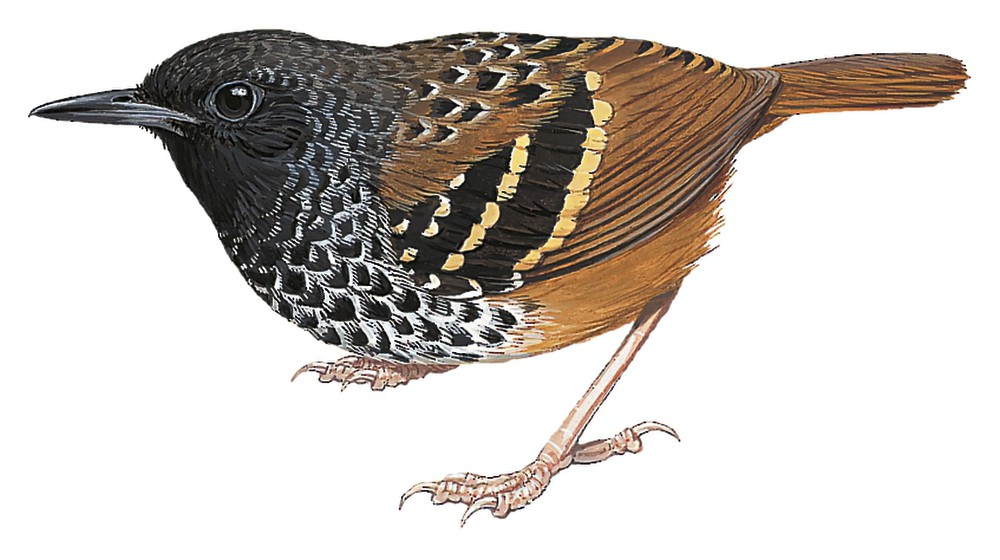Scalloped Antbird / Myrmoderus ruficauda

Scalloped Antbird
SCI Name:
Protonym: Myiothera ruficauda Beitr.Naturgesch.Brasil. 3 p.1060
Taxonomy: Passeriformes / Thamnophilidae / Myrmoderus
Taxonomy Code: scaant3
Type Locality: southeastern Brazil, = Rio Doce, Espirito Santo, by designation of Hellmayr, 1924.
Author: zu Wied
Publish Year: 1831
IUCN Status: Endangered
DEFINITIONS
MYRMODERUS
(Thamnophilidae; Ϯ White-bibbed Antbird M. loricatus) Gr. μυρμος murmos ant; δερω derō to thrash, to cudgel; "Myrmoderus gen. nov. (Formicariidæ.) Related to Myrmeciza Gray but tail much longer (more than five-sixths as long, sometimes longer than, wing, bill more slender, nostril larger and more longitudinal, and forehead more densely feathered, with feathers more compactly webbed, more decumbent; style of coloration very different. Type.— Myiothera loricata Lichtenstein. (Mυρμηξ, an ant; δερω, I flay, cudgel.)" (Ridgway 1909).
Synon. Myrmedestes.
ruficauda
L. rufus red, ruddy; cauda tail.
● ex “Jacamar à Queue Rousse” of Levaillant 1801 (Galbula).
● ex “Rouge-queue de Cayenne” of d’Aubenton 1765-1781, pl. 686, fig. 2 (syn. Synallaxis gujanensis).
● ex “Fauvette de Cayenne à queue rousse” of de Buffon 1770-1783, and “Rufous-tailed Warbler” of Latham 1783 (unident.).
SUBSPECIES
Scalloped Antbird (soror)
SCI Name: Myrmoderus ruficauda soror
soror / sorora
L. soror, sororis sister (i.e. closely related).
● "Ähnlich der X. f. flavigula Cab." (Neumann 1914) (subsp. Atimastillas flavigula).
● "Männchen dem vorgenannten Arten sehr ähnlich, im allgemeinen aber etwas kleiner, Schnabel wie bei B. puella, etwas schmaler als bei B. senegalensis und orientalis" (Reichenow 1903) (Batis).
● "Bisher habe ich unter dem Namen C. rufopileata Vögel von West- und Ostafrika zusammengefaßt. ... Als Typ für die Form soror ist ein Vogel vom Kilimandscharo. C. rufopileata scheint nur vom Niger bis zum Gabun verbreitet zu sein. Vögel von Loango gleichen der östlichen Form soror." (Reichenow 1916) (syn. Cisticola bulliens).
● "Der E. brunneiceps [= subsp. Erythropygia leucophrys] sehr ähnlich, aber kleiner" (Reichenow 1905) (syn. Erythropygia leucophrys zambesiana).
● "Von P. macrocerca (Lcht.) [= subsp. Euplectes macrourus] durch bedeutend geringere Grösse und etwas heller gelben Schulterfleck unterschieden" (Reichenow 1887) (syn. Euplectes macrourus).
● "This specimen may possibly prove to be an immature H. nipalensis, from which it differs in being slightly smaller and more slender in the tarsi" (Wardlaw Ramsay 1881) (Hydrornis).
● "Similar to pumila [= subsp. Lalage maculosa]" (Mayr & Ripley 1941) (subsp. Lalage maculosa).
● “typical Pachycephala, closely allied to P. melanura, but with the tail brown, bordered with olive-green” (P. Sclater 1874) (Pachycephala).
● "This subspecies is surprisingly similar to feminina [= subsp. Petroica pusilla], although the ranges of the two forms are widely separated by ambrynensis [= subsp. Petroica pusilla]" (Mayr 1934) (subsp. Petroica pusilla).
● "The name soror means sister, alluding to its close similarity with the other taxa in this [Seicercus (= Phylloscopus) burkii] complex" (Alström & Olsson 1999) (Phylloscopus).
● "Closely allied to M. castaneiceps, from which it differs in its much larger size" (Sharpe 1887) (subsp. Schoeniparus castaneceps).
● "The name of the subspecies is based on the close relationship of this indigobird with the other forms of the indigobird species" (Payne 1982) (syn. Vidua camerunensis).
● "Intermediär zwischen X. g. genibarbis Ill., aus Amazonien, und X. g. pelzelni [= syn. X. minutus] Hellm., aus S.-O.-Brasilien" (Hellmayr 1921) (syn. Xenops genibarbis).
Scalloped Antbird (ruficauda)
SCI Name: Myrmoderus ruficauda ruficauda
ruficauda
L. rufus red, ruddy; cauda tail.
● ex “Jacamar à Queue Rousse” of Levaillant 1801 (Galbula).
● ex “Rouge-queue de Cayenne” of d’Aubenton 1765-1781, pl. 686, fig. 2 (syn. Synallaxis gujanensis).
● ex “Fauvette de Cayenne à queue rousse” of de Buffon 1770-1783, and “Rufous-tailed Warbler” of Latham 1783 (unident.).
UPPERCASE: current genus
Uppercase first letter: generic synonym
● and ● See: generic homonyms
lowercase: species and subspecies
●: early names, variants, mispellings
‡: extinct
†: type species
Gr.: ancient Greek
L.: Latin
<: derived from
syn: synonym of
/: separates historical and modern geographic names
ex: based on
TL: type locality
OD: original diagnosis (genus) or original description (species)












